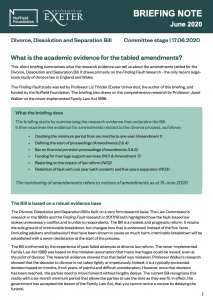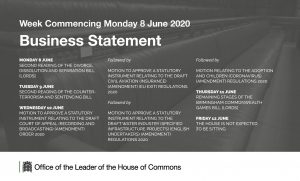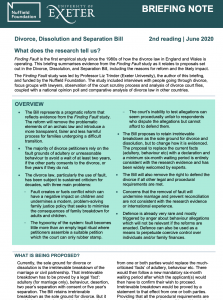[Update – this post refers to amendments to the Divorce Bill that fell with the dissolution of parliament in autumn 2019. The post will be updated if any of the amendments are laid down again in relation to the current Bill]
The post has been written by Liz Trinder, Professor of Socio-Legal Studies in the Law School, Exeter University and lead researcher on the Nuffield Foundation funded Finding Fault research study.
What this post covers:
- A very short summary of the problems with each group of amendments
- A short overview of the main provisions of the Bill
- Detailed commentary on each amendment (at 16thJuly 2019), grouped thematically
This is quite a long post. It is also available as a downloadable pdf
In Brief: problems with the individual amendments and why they should be rejected
- Retention of fault & separation (A8, 16, 17, NC3): ignores overwhelming case for reform
- Counselling and reconciliation (A7, 14, 15): too late, parties will focus on future
- Longer time periods (A9, 10-14, 19): reconciliation unlikely, delays would be punitive
- Bar on financial applications (A4, 6, 14): creates delay, punishes the most vulnerable
- Start of proceedings (A3, 5): starting at application is fairer due to service avoidance
- Children (A1, 2): the court cannot order parents to reconcile or create a happy family
- Recording lack of consent (NC4): a private matter, a public record could be misused
- Evaluation of reform (NC1): post-legislative scrutiny would be more effective
- Funding for counselling (NC2, A18, 19): wrong vehicle, must include cohabitants
Key: A = amendment, NC = new clause
1. Overview of the Divorce, Dissolution and Separation Bill
The government’s Divorce, Dissolution and Separation Bill is a response to long-standing and widespread criticism of the current law on the grounds for divorce and civil partnership dissolution. As the Ministry of Justice Consultation document and Response explain, the reliance upon allegations of fault to achieve a divorce within a reasonable timeframe creates unnecessary conflict, contrary to wider family policy goals. The law is also unfair, confusing and hypocritical, encouraging many to make up or exaggerate allegations of conduct which the court cannot then investigate. There is also no evidence that the current grounds protect marriage or civil partnership.
The Bill is a targeted reform. It retains what works about the current law, but removes the elements that create unnecessary harm. The sole ground (or reason) for divorce or dissolution will continue to be irretrievable breakdown. The main difference is that irretrievable breakdown will be evidenced by a declaration to that effect, rather than by one of the much-criticised five legal facts of adultery, (unreasonable) behaviour, desertion, two year’s separation with consent or five year’s separation.
It will also no longer be possible to ‘defend’ a divorce if all procedural requirements have otherwise been met. This would prevent cases such as Owens vs Owens where the wife remained trapped in a marriage for five years despite it being evident that the marriage was irretrievable.
The Bill will introduce some procedural differences. It will be possible to make a joint as well as a sole application, reflecting that it is often a mutual decision. The government is also concerned that the process is a considered one. The Bill will introduce a new minimum overall waiting period of six months. This will be divided between a twenty-week period from application to conditional decree (formerly decree nisi) and six-weeks from conditional to final decree (formerly decree absolute).
The Bill had cross-party support at Second Reading and in Committee Stage. The current progress of the Bill can be checked here. For background reading on the Bill (and the need for reform) see the House of Commons Library Briefing on the Bill and the Finding Fault briefing on the research evidence for reform and the likely impact of the Bill.
2. Commentary on each group of amendments
Retention of mixed-fault divorce (Amendment 8 & New Clause 3, Amendments 16 & 17)
Proposed amendments
A group of four amendments would result in the retention of the existing law, with minor changes. Amendment 8 would remove Clause 1 of the Bill, thereby retaining the current means of evidencing irretrievable breakdown of a marriage by reference to fault (adultery, behaviour or desertion) or a period of separation. The only difference would be that New Clause 3 would reduce the current separation periods from two years to one year where the respondent consents to the divorce, otherwise from five to two years.
Amendment 16 would restrict the application of the Act to marriages conducted after the commencement of the of the Act, i.e. retaining the mixed-fault regime for all existing marriages for the next several decades. Amendment 17 would retain the mixed-fault regime for existing (pre-commencement) marriages where the application is from one party only, again for the next several decades.
All four amendments relate only to marriage. They do not affect the Bill’s provisions for civil partnership dissolution.
Comment
The four amendments would retain the mixed-fault system in its entirety, or for the great majority of divorces, for the foreseeable future. There is no recognition that parliament had previously accepted the case for no-fault divorce in 1996, the widespread calls for reform from stakeholders or the cross-party support for the Bill to date. The retention of the mixed-fault system ignores the fundamental problems identified by the Law Commission in the 1990s and replicated in the Finding Fault study. Those problems include the manipulation of the grounds to secure a faster divorce, the unnecessary triggering or exacerbation of conflict and the unfairness to the respondent subject to allegations that they cannot defend.
It is highly unlikely that the introduction of shorter separation periods would significantly reduce the disproportionate reliance upon fault in England & Wales, currently about 60% of divorces. Average court processing times of six months would mean a petitioner relying on separation would still be waiting a minimum 18 months if the respondent consented, or 30 months if consent could not be relied upon or was withdrawn. In contrast, the average wait time for an adultery or behaviour divorce was six months in the Finding Fault study and could be as little as three or four months. The behaviour fact would remain a much less risky and quicker route, and therefore the only realistic option for many despite the known problems with using a fault fact.
Further, it has long been recognised that the separation facts are discriminatory. It is not a realistic option for many families to buy or rent two houses before the finances are settled, particularly in high cost areas such as London and the south-east. Living separately under the same roof is technically possible, but the rules are archaic and contrary to child welfare. The ‘Mouncer’rules require that meals are taken separately. Parents trying to create a ‘normal’ family life for their children by having family meals during the two- or five- year separation would be deemed to be living together and therefore not entitled to a divorce. In addition, retrospective separation dates can be easily faked. In contrast, the waiting period set out in the Bill’s do not preclude the parties continuing to share a household and cannot be faked.
There is no historical precedent for introducing divorce reform that operates only prospectively. All previous reform has applied to all marriages, not just those conducted after the reform.
The four amendments (and all others handed in by Sir Edward Leigh) apply only to marriage, not civil partnership. The effect would be to break a fundamental principle that marriage and civil partnership should be treated as functional equivalents.
If the amendments were accepted, they would create two entirely different legal regimes: the existing mixed-fault regime for all or sole application marriages conducted before commencement and the Bill’s proposed no-fault regime for all marriages and civil partnerships. That situation would be discriminatory and unfair.
It would also be a recipe for confusion. One of the many advantages of the Bill is that it removes the complexity of the current system. Legal clarity and transparency is a critical component of the rule of law and is particularly important when the majority of the parties are not legally represented.
Counselling and reconciliation periods (Amendments 7, 14 & 15)
Proposed amendments
Amendment 7 would require provision of information on relationship support or counselling to parties to an application as an alternative to divorce.
Amendment 14 would divide the twenty weeks from application to conditional order into two discrete periods: a 12-week ‘reconciliation period’ followed by a 20-week ‘reflection’ period. No financial order applications would be allowed in the ‘reconciliation’ period. Amendment 15 would enable a 12-week ‘reconciliation period’ to be curtailed if the spouses met at least three times with a marriage counsellor “to help effect a reconciliation”.
Comment
None of the three amendments are helpful.
The online divorce system does already offer information about relationship counselling. The government website gov.uk recommends that the first step in the divorce process is to get support and advice, and includesa link to Relate and a Directory of Counsellors. That information is described as a means to “help you through the divorce”, but obviously would also enable the parties to get relationship support if they wished to continue the marriage.
The online site could, in future, helpfully provide further links to online tools to help the parties make future arrangements for children or finances. What is important, however, is that the Bill does not require the parties to attend an information meeting or counselling or consider reconciliation. Any information provided through the online application system is an offer to the parties, not a requirement.
What the Bill does do is to help ensure that the process is a considered one by requiring a minimum period of six months from the application. It is left to the parties to determine how best to utilise the time given their own particular circumstances. The Bill also retains three stages – or a ‘triple lock’ – where the applicant(s) must reaffirm their wish to proceed (at application, application for conditional order and application for final order). Each of the three stages gives an opportunity for the parties to change course if they choose to do so. Indeed, as case progression depends upon taking three active steps to continue, changing course simply means not taking any step. The continuation of the triple lock is in contrast to similar jurisdictions where divorce or dissolution can follow only one or two actions by the applicant(s).
There are two main reasons why the government’s approach is preferable to the three amendments. First, it is based on the evidence of how relationships break up and when the legal divorce is initiated. It should be noted that by the time that a divorce application has been made, the national and international evidence is that it is generally too late for marriages or civil partnerships to be repaired. The extensive research conducted into the Family Law Act information pilots and the Finding Fault research showed clearly that the decision to divorce is not taken lightly or impetuously. Indeed, it is a typically protracted decision based on months, if not years, of painful and difficult consideration.
Not surprisingly, there was limited take up of the offer to meet a relationship counsellor as part of the Family Law Act pilots. Those who did take up the offer typically used the session to come to terms with the ending of the marriage and focus on the future, rather than to explore the possibility of reconciliation. Only a handful of marriages were continued as a result. More recently, analysis of the Finding Fault data indicated that the 10% of cases that do not reach decree absolute each year is because of procedural difficulties, not because of an attempted reconciliation.
The second reason for preferring the government’s approach is the problem of the state not respecting or undermining private decisions. The parties may have already been separated for years and so an externally imposed delay would be extremely unfair. But there is a particular concern that victims of abuse, who may have taken a long time to summon the courage to leave an abusive marriage, would be discouraged by actual or perceived pressure to reconsider their decision. Domestic abuse is not a rare phenomenon. In the Finding Fault study, 42% of a nationally representative sample of behaviour divorces included allegations of domestic abuse, some of an extremely serious nature.
The differential treatment of civil partnership and marriage in all three amendments is also a concern.
Length of time periods (Amendments 9, 10 & 14 and 11-13)
Proposed amendments
Three amendments would extend the overall six-month time frame for divorce set out in the Bill. The twenty-week period between application and conditional order would be extended to 32 weeks by Amendment 14 and to 40 weeks by Amendment 10. Amendment 9 would extend the period between conditional and final order from 6 weeks to 12. The effect would be to extend the minimum 26-week period to a possible 44 or 52 weeks.
A further three amendments seek to restrict the powers of the Lord Chancellor to amend the time periods. Amendments 11 & 12 would remove Clause 1 (6) and (7)) which give the Lord Chancellor power to amend the length of two periods (within an overall maximum of 26 weeks). Amendment 13 would require draft SIs to be approved by parliament, rather than giving parliament power to annul any SIs made.
All six amendments apply solely to divorce, not civil partnership dissolution.
Comment.
The six-month minimum period set out in the Bill is consistent with other similar jurisdictions that have recently reformed the divorce law, such as Finland and New York State. It is also consistent with the needs and preferences of divorcing couples. At present, 60% divorce on fault grounds where the average length of proceedings is six months, but having to produce potentially toxic or fabricated fault allegations.
The research evidence shows that the decision to divorce is a very difficult and typically protracted one. Consequently, few spouses will reconcile during the divorce process. Extending the minimum waiting period would be a punitive step and delay families making necessary decisions about their future.
The differential treatment of marriage and civil partnership is not appropriate.
Bar on financial applications (Amendments 4, 6 & 14)
Proposed amendments
Amendments 4 & 6prevent financial applications being made in divorce ordissolution applications during the twenty-week period, unless both parties agree or the application is for interim maintenance and financial injunctions. Amendment 14 subdivides the application to conditional order (in divorces only) into two discrete periods – a 12 week ‘reconciliation period’ followed by a 20-week reflection period. No financial provision proceedings may be issued in the 12-week reconciliation period.
Comment
The government’s aim is to ensure that the divorce/dissolution process is a considered one (see Explanatory Notes). In the great majority of cases, the research evidence shows that the final decision to divorce/dissolve the civil partnership has already been taken well before applications are made. The twenty-week period will therefore be used in most cases to begin the process of agreeing arrangements for finances and children. It is neither appropriate, nor desirable, for the state to prevent the parties from planning for their future by barring financial applications during this period, not least as it can take many months to reach an outcome.
The amendments would be particularly damaging for the most vulnerable parties. It would, for instance, prevent a woman trying to leave an abusive marriage from starting proceedings immediately to permanently resolve the family finances, either at all in the case of amendment 14 or unless her spouse agreed. Both situations would be ripe for exploitation by the abusive spouse. The latter might simply refuse to agree to start financial proceedings in order to maintain control of the woman and the finances for as long as possible. Alternatively, those applicants who simply cannot wait might be forced to give up on the prospect of pursuing financial orders at all or to trade an unfair financial division to secure the spouse’s agreement to commence financial proceedings during the twenty-week period. Each scenario is unfair, unjustifiable and potentially dangerous.
As before, the differential treatment of marriage and civil partnership cannot be justified.
Defining the start of proceedings (Amendments 3 & 5)
Proposed Amendments
Amendments 3 and 5 would define the start of the twenty-week period, for divorce and dissolution respectively, at application for joint applications or when notice of an application has been ‘received’ in sole applications.
Comments
This is a more finely balanced issue than other amendments as it concerns the respective rights of applicants and respondents in sole applications.
It is important that respondents in sole application cases are given sufficient time to adjust emotionally and to start planning for the future. Starting the clock when an application is ‘received’, as the amendments propose, would maximise the time available to the respondent. A similar approach is adopted in some other jurisdictions, including Sweden and Finland, where the clock starts ticking only on delivery to the non-applicant.
However, in Sweden and Finland all citizens must officially register their current address. Service is taken as proof of delivery to that registered address, regardless of whether the person actually receives the notice. The situation is different in England & Wales. The rules are far more onerous. They require that the respondent must acknowledge service, not just by ‘receiving notice’, but by returning a signed copy of the acknowledgement of service to the court. That puts the respondent in a very powerful position as the divorce cannot proceed without their cooperation.
Respondents can, and do, exploit that ability to control the progress of the case. In the Finding Fault research, a tenth of respondents took two months or more to return the acknowledgement. Some took more than a year. A further 14% of respondents did not respond at all. That non-response had a serious impact on the progress of the case. Nearly half (44%) of the 41 non-response cases failed to reach decree nisi, compared to only 3% of cases where the acknowledgement had been returned. The non-response cases that did manage to reach decree nisi, took twice as long to get there as cases where the acknowledgement was returned promptly, a median 30 weeks (or 7.5 months) compared to 15 weeks. If the clock only starts ticking at receipt of acknowledgement, those cases would have to wait for a further twenty weeks after a long delay. Whilst 14% of cases would seem a small proportion, extrapolated nationally it would amount to about 8,000 cases annually taking twice as long to reach conditional order and 6,000 failing to reach conditional order at all.
Very few of the late or non-responses in the Finding Fault sample appeared to result from difficulty in locating the respondent, even those living abroad. Instead, the majority of the non-returns appeared to be respondents choosing not to cooperate with the process, i.e. actively frustrating service. In particular, there was evidence that non-response was more likely to occur in cases featuring allegations of domestic abuse/coercive control, and indeed it appeared to be used as a further instance of controlling behaviour. In a small number of cases, the non-response appeared to result from the respondent’s mental health difficulties and/or chaotic lifestyles.
In contrast, there is limited evidence that respondents would be significantly disadvantaged by timing the start of the process from application. The standard practice is that the court initially serves the application on the respondent, meaning there should be no delay providing that contact details are correct. All 300 petitions in the nationally representative Finding Fault sample were served by the court, rather than the petitioner. However, the revision to the Family Procedure Rules could require that service can only be conducted by the court at first instance, rather than an applicant who might want to delay service until the last moment.
Concerns have also been expressed that a respondent might receive a divorce or dissolution application out of the blue, with no knowledge that the relationship was in trouble and (possibly) with limited time to react. Further analysis of the Finding Fault sample would suggest that this type of ‘bombshell’ application would be quite rare. There were no instances amongst any of the sample of 81 qualitative interviews. Instead, and consistent with previous research, most breakups were not sudden events, but occurred over time. In the minority of cases where the breakup was unexpected, it was the non-initiator of the breakup who later went on to initiate the legal divorce.
Numerically, the weight of evidence suggests that the more likely risk of harm stems from the known deliberate evasion of service by the respondent, compared to a more hypothetical risk of delayed service by the applicant. The consequences are also rather different. Failure to acknowledge service risks extensive delays to the legal process or no divorce or dissolution at all. Delay in serving the respondent means less time to react, but the loss of time would be capped.
Starting the process at application would seem to be the fairest approach in a situation where a balance must be struck. The government has stated that a conditional order will not be granted without satisfactory evidence of service (i.e. return of the acknowledgement of service) and that it will explore safeguards to protect the interests of respondents where there are difficulties with the service of documents. Those protections would be set out in secondary legislation and in the Family Procedure Rules which would be consulted upon.
Divorces with children (Amendment 1 & 2)
Proposed amendments
Amendments 1 and 2 would prevent the making of a divorce or dissolution order if the court is not satisfied that the divorce or dissolution is in the children’s interests.
Comment
Until 2014, the court was required to scrutinise a ‘statement of arrangements’ for children and consider whether it should exercise any of its powers under the Children Act 1989 before it could grant a divorce decree or dissolution order. This duty under s.41 Matrimonial Causes Act 1973 and s.63 Civil Partnership Act 2004 was repealed by s.17 of the Children and Families Act 2014. Research had shown that the ‘welfare check’ was ineffective, with little more than ritual scrutiny of information supplied by the parents. The Explanatory notes to the Draft Children and Families Bill noted that the “vast majority” of parents agree arrangements for children at divorce (para 66). A better alternative therefore was for any disputes about children to be brought in separate Children Act proceedings.
There have been no subsequent concerns raised that the removal of the s.41/s.63 ‘welfare check’ has had any adverse consequences for child welfare. Instead of a perfunctory check for a selected group of children at a specific time point, the onus is on any parent being able to bring a Children Act application at any point where there is a dispute about arrangements. This position is consistent with wider family justice policy which emphasises the responsibility of parents to act in their children’s best interests. It is also consistent with the research evidence that parents are very mindful of the impact of family separation on their children and do what they can to mitigate it.
Amendments 1 & 2 would go significantly further than the repealed s.41/s.63 as they would enable the court to refuse a divorce or dissolution order. However, even if the court could be made aware of any concerns, it is highly unlikely that the court’s refusal to grant the legal divorce or dissolution would force the parents to reconcile, let alone create a happy and positive environment for their children. Instead, it is likely that the marriage would continue in name only, existing purely as a dead or ‘limping’ marriage with adverse consequences for all, including children.
The proposed amendments would be impossible to operate in practice and would undermine, not support, child welfare.
Recording lack of consent (New Clause 4)
Proposed amendment
The new clause would enable a respondent to a sole application to formally record their lack of consent to the divorce (but not to a civil partnership dissolution) if they so choose.
Comment
Relationship breakdown can be a very fraught and conflictual time. No law can prevent that, but a good law will reduce the opportunity to weaponise the process and deepen the conflict. Currently there are instances of parents who threaten to show a behaviour petition to children. Providing an official written record of non-consent could be used in exactly the same way to fuel conflict.
Whether someone opposes the divorce is a private matter between the parties. It should not be recorded as part of a court process. Indeed, a review of similar jurisdictions found no examples where a wish to preserve the marriage could be formally recorded, whether in jurisdictions with no mechanisms for defence or those where defence is only a theoretical possibility.
Evaluation of reform (New Clause 1)
New Clause
This clause requires the Secretary of State to report annually to parliament on the impact of reform on divorce proceedings and marriage, with the report to include statistics on divorce applications, numbers seeking marriage counselling etc.
Comment
It is vital that the impact of any reform is evaluated, particularly in such a sensitive area of policy. However, the proposed amendment is far too imprecise to enable parliament to assess fully the impact of the reform. The requirement to collect the numbers of parties undertaking relationship counselling is not achievable. It would be of little value, in any case, as there is no baseline data to enable a comparison. The proposed requirement to collect data on the number of divorces is redundant as the Office for National Statistics already publishes comprehensive annual statistics on divorceand civil partnership dissolution, including by marriage duration, age and gender of the parties etc.
Post-legislative scrutiny would be a far more appropriate mechanism to assess whether the Act was working as intended and whether there were any unforeseen or undesirable effects.
Funding for counselling services (New Clause 2 & Amendments 18 & 19)
Proposed amendments
NC2 would convert the existing power to fund marriage support services into a duty and also extend it to cover civil partnerships. Amendments 18 and 19 would prevent commencement before substantial grants for marriage support services had been made under s.22 FLA or there was a plan to do so.
Comment
Far greater funding for relationship support services would be very welcome. Too often, those with limited means are unable to start, or continue with, counselling (see https://www.relate.org.uk/investinrelationships). The Finding Fault report concluded with a recommendation that any money saved as a result of law reform should be redirected to relationship support services.
However, as the Secretary of State noted in the Second Reading debate, that is a spending choice for government and a Bill dealing with the legal process for marriages and civil partnerships that have already broken down is not an appropriate vehicle to achieve that. Nor would it be appropriate to delay implementation of a much-needed Bill to address those issues.
More broadly, it is doubtful whether the Ministry of Justice is the appropriate department to deal with relationship support. It is not a justice issue and it will never get the attention it requires. The Department of Health or DWP would be far more suitable departments.
As a final point, amendments 18 and 19 would only make relationship support services available to married couples. New Clause 2 would provide services to married couples and civil partners, but exclude cohabitants. Both approaches are unfairly restrictive. They also ignore the evidence that cohabiting relationships are more vulnerable and therefore more in need of support services.













